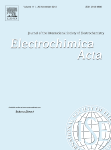Electrodeposition of Fe-Ga thin films from eutectic-based ionic liquid.
 Author(s): ZHAO F., FRANZ S., VICENZO A., BESTETTI M., VENTURINI F., CAVALLOTTI P. L.
Author(s): ZHAO F., FRANZ S., VICENZO A., BESTETTI M., VENTURINI F., CAVALLOTTI P. L.
Source: Electrochimica Acta.
doi:10.1016/j.electacta.2013.07.172 (2013).
ABSTRACT:
In the present work, a novel process for Fe-Ga thin films electrodeposition is addressed and the magnetic properties of the films are studied. The electrodeposition was carried out under ambient conditions using an ionic liquid electrolyte consisting of a mixture of choline chloride and ethylene glycol in the molar ratio 1:2, containing 0.3 M FeCl2 and 0.1 M GaCl3, either in the absence or in the presence of oxalic acid at 4 or 17 mM concentration. The effect of oxalic acid on the discharge reaction of the single ionic species Fe2+ and Ga3+ and on their codeposition was investigated by linear sweep voltammetry, suggesting a specific action of oxalic acid on the cathodic reduction of Ga3+ ionic species. Depending on deposition potential and oxalic acid concentration, alloy films with Ga content variable in the range up to about 20 at.% could be obtained. The Fe-Ga thin films showed a disordered body-cantered cubic phase (A2) with (110) preferred orientation and columnar microstructure, with a drastic change from pyramidal to granular surface morphology revealed raising the deposition potential. No superlattice reflections, indicating the formation of the D03 structure, were observed. A vibrating sample magnetometer was employed to measure hysteresis loops by applying longitudinal and transversal magnetic field on the Fe-Ga film plane. The saturation magnetization of as-deposited film reached 1.75 T for Fe83Ga17 thin films, confirming that good quality films were obtained. For the same alloy composition, the coercivity values were 67 Oe and 200 Oe, with applied field parallel and perpendicular to the film plane, respectively. http://www.sciencedirect.com/science/journal/aip/00134686


